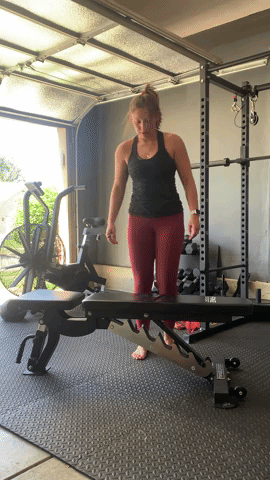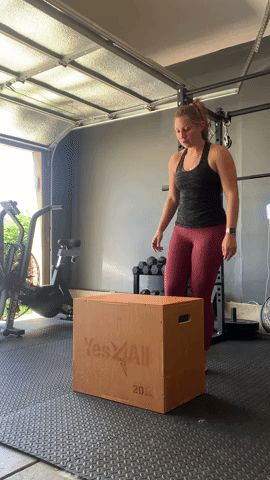Improve your step-up (Part 1)
If you’ve been around for a bit, you already know I love step-ups (of all kinds).
But something I haven’t talked about as much is how to improve your step-up so let’s dive into part 1 of 2 right now!
The issue
One of the most common issues I see with step-ups is lacking balance and/or stability at the base of the lift.
That might look something like the video below where you can see my foot on the bench is wobbly (which causes the rest of my body to be wobbly) throughout the up and down phases.
The wobble.
Watch my feet, ankles and knees in this step-up. You can see as I raise up in the movement my lack of balance and stability at my base affects the entire movement.
Performing your step-up on a sturdy surface is key to allowing you to execute it well… and while a workout bench is designed to be sturdy, it’s also designed to be comfortable for movements that require you to lay or brace yourself on the bench top.
In a step-up where you want a solid base to stand on, benches can be counter-productive and cause issues like the wobble.
A quick swap to a box (if you’re able to) can make a monumental difference in the integrity of your step-up.
Swap the surface.
A quick swap to a box can make a monumental difference in the integrity of your step-up.
Start with this change if you’re able to make it.
Benches tend to be more readily available at gyms and are more common in home-gyms than boxes so if you aren’t able to make the switch to a box, try going barefoot or with just socks on.
This can help you feel the bench below your foot better and remove unnecessary cushion in your shoe.
If you go this route, think about gripping the bench with your foot and balancing your weight evenly on your foot tripod: big toe, pinky toe, heel.
(also PLZ wipe down your bench after - even if you wear shoes - THX!!)
If you cringe thinking about going barefoot or in socks at the gym you can try taking a moment to rest your opposite foot’s toes on the bench once you get to the top of your step-up like I do in the box video above.
Now let’s say you’re doing all of that and still feel wobbly, try “lowering” the height of the step by standing on a plate instead of the floor.
This raises your starting point so the distance you are stepping up is less even though the bench is the same height.
If you exhaust all of these options then it’s possible there are some other movements you should be working on improving before diving into a step-up. A qualified coach will be able to help you sort out your specific approach to do this.
Have questions?
Drop them in the comments or send me a message to talk through it.
Chat soon-
Kirsi


